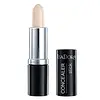What's inside
What's inside
 Key Ingredients
Key Ingredients

 Benefits
Benefits

 Concerns
Concerns

 Ingredients Side-by-side
Ingredients Side-by-side

Caprylic/Capric Triglyceride
MaskingOctyldodecanol
EmollientBis-Diglyceryl Polyacyladipate-2
EmollientSynthetic Wax
AbrasiveCandelilla Cera
EmollientKaolin
AbrasiveHydrogenated Dimer Dilinoleyl/Dimethylcarbonate Copolymer
Emulsion StabilisingDicalcium Phosphate
AbrasiveTribehenin
EmollientDisteardimonium Hectorite
StabilisingBoron Nitride
AbsorbentSynthetic Fluorphlogopite
Mica
Cosmetic ColorantPolyhydroxystearic Acid
EmulsifyingPhysalis Pubescens Fruit Juice
Skin ConditioningPentaerythrityl Tetra-Di-T-Butyl Hydroxyhydrocinnamate
AntioxidantTin Oxide
AbrasiveTocopherol
AntioxidantCI 77891
Cosmetic ColorantCI 77492
Cosmetic ColorantCI 77491
Cosmetic ColorantCI 77499
Cosmetic ColorantCI 42090
Cosmetic ColorantCaprylic/Capric Triglyceride, Octyldodecanol, Bis-Diglyceryl Polyacyladipate-2, Synthetic Wax, Candelilla Cera, Kaolin, Hydrogenated Dimer Dilinoleyl/Dimethylcarbonate Copolymer, Dicalcium Phosphate, Tribehenin, Disteardimonium Hectorite, Boron Nitride, Synthetic Fluorphlogopite, Mica, Polyhydroxystearic Acid, Physalis Pubescens Fruit Juice, Pentaerythrityl Tetra-Di-T-Butyl Hydroxyhydrocinnamate, Tin Oxide, Tocopherol, CI 77891, CI 77492, CI 77491, CI 77499, CI 42090
Water
Skin ConditioningCyclopentasiloxane
EmollientMica
Cosmetic ColorantCyclohexasiloxane
EmollientButylene Glycol
HumectantPEG-10 Dimethicone
Skin ConditioningGlycerin
HumectantKaolin
AbrasiveDipentaerythrityl Pentaisononanoate
EmollientPhenyl Trimethicone
Skin ConditioningCetyl PEG/PPG-10/1 Dimethicone
EmulsifyingSodium Chloride
MaskingDisteardimonium Hectorite
StabilisingTrimethylsiloxysilicate
EmollientBenzyl Alcohol
PerfumingPropanediol
SolventTriethoxycaprylylsilane
Magnesium Stearate
Cosmetic ColorantTalc
AbrasiveAluminum Hydroxide
EmollientSalicylic Acid
MaskingTin Oxide
AbrasiveSorbic Acid
PreservativeHydrogen Dimethicone
Vitis Vinifera Juice Extract
AntioxidantCI 77891
Cosmetic ColorantCI 77491
Cosmetic ColorantCI 77492
Cosmetic ColorantWater, Cyclopentasiloxane, Mica, Cyclohexasiloxane, Butylene Glycol, PEG-10 Dimethicone, Glycerin, Kaolin, Dipentaerythrityl Pentaisononanoate, Phenyl Trimethicone, Cetyl PEG/PPG-10/1 Dimethicone, Sodium Chloride, Disteardimonium Hectorite, Trimethylsiloxysilicate, Benzyl Alcohol, Propanediol, Triethoxycaprylylsilane, Magnesium Stearate, Talc, Aluminum Hydroxide, Salicylic Acid, Tin Oxide, Sorbic Acid, Hydrogen Dimethicone, Vitis Vinifera Juice Extract, CI 77891, CI 77491, CI 77492
Ingredients Explained
These ingredients are found in both products.
Ingredients higher up in an ingredient list are typically present in a larger amount.
Ci 77491 is also hydrated iron III oxide. It's sole purpose is to give a red/pink hue to products.
Iron III oxides are classified as inorganic chemicals for coloring.
Synthetically created Ci 77491 is considered safer than those naturally found. This is because the synthetically created version may contain less impurities. Iron oxides are generally non-toxic and non-allergenic.
Learn more about CI 77491Ci 77492 is also hydrated iron III oxide. It's sole purpose is to give a yellow hue to products.
Iron III oxides are classified as inorganic chemicals for coloring.
Synthetically created Ci 77492 is considered safer than those naturally found. This is because the synthetically created version may contain less impurities. Iron oxides are generally non-toxic and non-allergenic.
Learn more about CI 77492Ci 77891 is a white pigment from Titanium dioxide. It is naturally found in minerals such as rutile and ilmenite.
It's main function is to add a white color to cosmetics. It can also be mixed with other colors to create different shades.
Ci 77891 is commonly found in sunscreens due to its ability to block UV rays.
Learn more about CI 77891Disteardimonium Hectorite comes from the clay mineral named hectorite. It is used to add thickness to a product.
It can also help stabilize a product by helping to disperse other ingredients.
Hectorite is a rare, white clay mineral.
Learn more about Disteardimonium HectoriteKaolin is a clay. It is used for oil control and to help minimize pores. Like other clays, kaolin has the ability to absorb excess sebum or oil. This can help clean out pores and mattify the skin.
Some types of kaolin may have exfoliating properties. When water is added to kaolin, it becomes a paste with small abrasive particles.
Most kaolin is a white color, but may be pink/orange/red depending on where it comes from.
The name 'kaolin' comes from a Chinese village named 'Gaoling'. Kaolin clay comes from rocks rich in kaolinite. Kaolinite, the mineral, has a silicate layered structure. Kaolinite is formed from chemical weathering of aluminum siilicate minerals.
Besides skincare, kaolin is commonly used to make glossy paper, in ceramics, toothpaste, and as medicine to soothe stomach issues.
Learn more about KaolinMica is a naturally occurring mineral used to add shimmer and color in cosmetics. It can also help improve the texture of a product or give it an opaque, white/silver color.
Serecite is the name for very fine but ragged grains of mica.
This ingredient is often coated with metal oxides like titanium dioxide. Trace amounts of heavy metals may be found in mica, but these metals are not harmful in our personal products.
Mica has been used since prehistoric times throughout the world. Ancient Egyptian, Indian, Greek, Roman, Aztec, and Chinese civilizations have used mica.
Learn more about MicaTin Oxide is an inorganic oxide used to add opacity and volume to a product. In nature, it is already found in mineral form. The main ore of tin is an opaque and shiny mineral called casseterite.
Tin Oxide helps remove translucency in a product, or make it more opaque. Besides adding opacity, tin oxide is used for bulking to add volume.